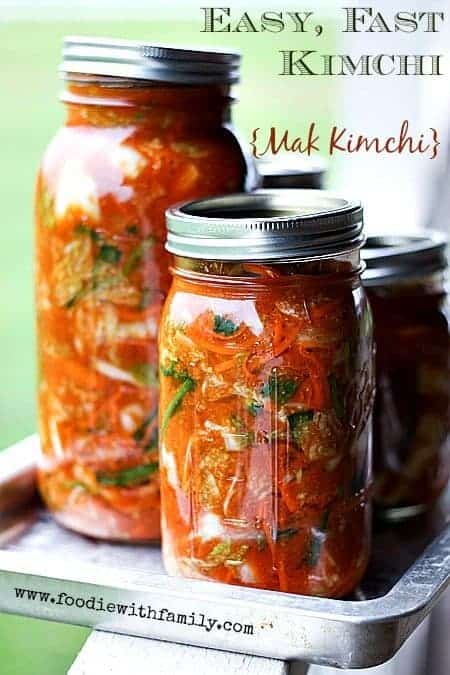
Love this Easy, Fast Mak Kimchi recipe? Check out our other fabulous Korean Food Recipes!
If you’ve been with me for a while, you’re well aware of my undying love for kimchi. Yes, it is stinky and bubbly and more than a little wild, but WOWZA the taste and the texture are so worth it.
If you’re new to the Foodie with Family family and you aren’t familiar with kimchi, I can give you a super condensed description; it’s essentially spicy, aromatic Korean sauerkraut. Today, I’m bringing you a fool-proof Easy Fast Kimchi recipe {Mak Kimchi}.
What is Kimchi?
Kimchi comes in almost as many forms as there are vegetables because nearly any vegetable can be fermented. They range from super mild smell to mega funky and mellow to melt-your-face-off spicy and there is one for every possible point in between.
The kimchi recipe that I’m sharing today is my family’s favourite version. It’s chock full of fabulous pro-biotics (as most kimchi is) and the longer it ages (translation: ferments) the stronger it becomes in both flavour AND pro-biotic content.
It’s like yogurt on steroids, people. That’s how good it is for you!
Is Kimchi Good For You?
Health Magazine named kimchi one of it’s Top 5 World’s Healthiest Foods. It is is low in calories and fat and high in dietary fiber and wicked high in Vitamins A, B, and C.
Many (if not most) Koreans eat a little kimchi with each meal or at least once a day. Kimchi is credited with helping most Koreans avoid obesity by virtue of its ability to satisfy even while being low calorie and low fat.
Seoul National University conducted a study and claimed that chickens infected with the H5N1 virus, also called avian flu, recovered after eating food containing the same cultured bacteria found in kimchi. That’s good enough for me!
How to Make Kimchi
Let’s get cracking and make some kimchi, shall we? The variety we’re making today is an Easy, Fast Kimchi recipe or Mak Kimchi…
In other words, it’s already cut up and ready to shovel into your mouth. Unlike what is usually just called ‘kimchi’ which is whole heads of napa cabbage smeared with the kimchi paste and allowed to ferment all wrapped up.
This version is FAR easier to make and far faster to be ready. Bonus, it is way easier to eat straight from the jar with a pair of chopsticks or a fork.
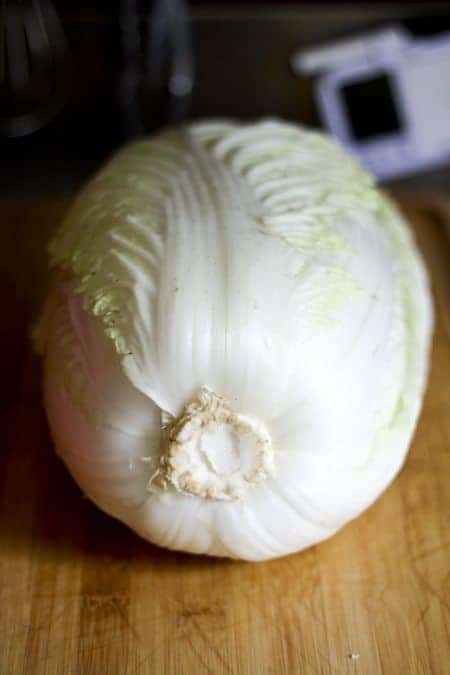
Do I need special tools to make kimchi?
In short, no. All you really need is a knife, a cutting board, and a big bowl. You will need a couple of ingredients that you may not have purchased before, but never fear, they’re not hard to find these days and I’ve included links to them below.
To begin with, you’ll need a big old head or two of Napa cabbage. I had two heads like the one above weighing in at about 3 pounds each.
It yielded, when all was said and done, about 3 quarts of kimchi, so that was perfect for me. You can cut that back if you think you can’t consume that amount of our Easy, Fast Kimchi recipe or Mak kimchi.
But I find all sorts of places to tuck it in, so it’s not an issue here and it’s only my husband, myself, and two of our boys who eat it. We love our kimchi.
Kimchi Recipe
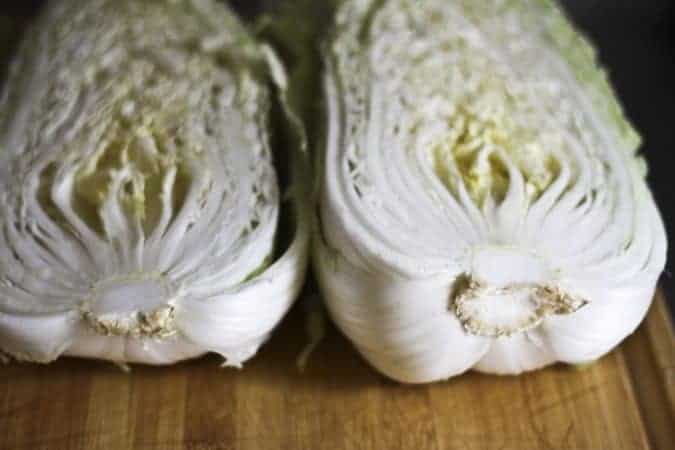
Lob your cabbages in half lengthwise. Use a paring knife to remove the gnarly core from them before cutting in half lengthwise again, leaving you with quarters.
Cut across the quarters to make bite-sized squares of cabbage. I usually shoot for 2-inch squares.
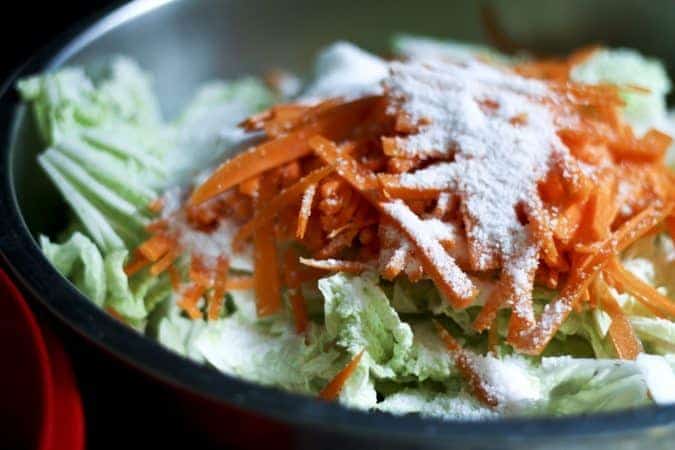
Add the cabbage to a monstrously huge bowl (or bowls), top with the julienned carrots, and sprinkle salt over the whole works. Toss the veggies and massage the mixture until the cabbage just starts to wilt.
Pour in enough cold water to over all the cabbage and carrots by a bit. It doesn’t have to be swimming in water, just covered.
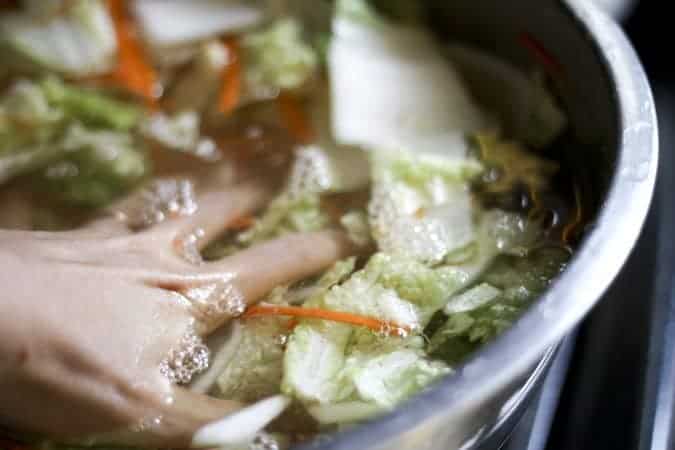
Stir it up with your hands and let it rest at room temp for a couple of hours.
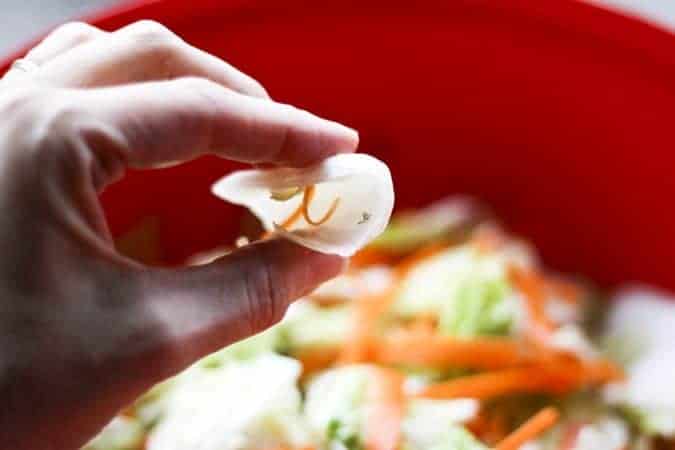
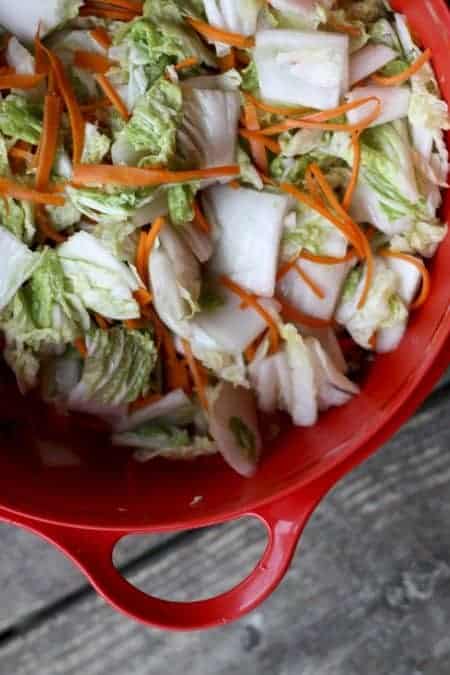
After a couple of hours, when the sturdier pieces of cabbage have become flexible, pour the whole lot into a strainer and let the brine water drain away.
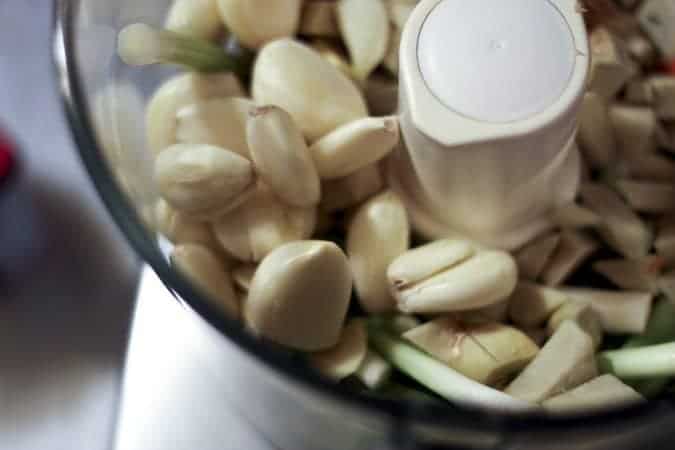
Now you’re going to whizz up the good stuff. Garlic, ginger, the white parts of scallions, Korean Red Pepper Powder*, fish sauce, unsweetened pear or apple juice, miso paste, and whatnot go into the food processor or blender.
Obliterate and smash it all into a lovely, red, fabulous smelling paste. It’s worth noting that you shouldn’t just up and increase the garlic because it can make kimchi linger more on your breath than you’d like it to do.
It also tastes out of balance if you add a lot more. Be aware.
And by the same token, you shouldn’t increase the ginger willy-nilly because that can make the final product a little more bitter than you’d like it to be. Start with the mixture and proportions I’m giving you and then play with it in subsequent batches.
*It’s important to note that you cannot use American or Mexican Chili Powder in place of the Korean pepper powder here. They’re COMPLETELY different animals. It may end up tasty, but I haven’t tested it so I cannot speak to it.
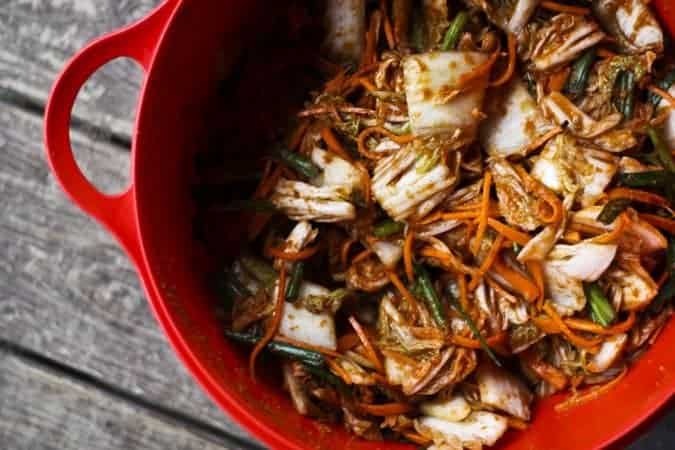
Now you’ll CRAM this stuff into jars or food-safe plastic containers. When I say cram it, I mean shove it in there as firmly as you can without putting your fist through the bottom of the jar.
I do prefer glass canning jars, if you’re wondering, because they don’t retain odors like plastic does, and, well, this stuff is odiferous! You can use a dedicated plastic kimchi bucket if you’d prefer, though.
Gently place a lid and ring on the jar, but don’t screw it tightly into place because BOOM. It’ll pop. This is active stuff, mes amies!
Place the jar on a rimmed pan or baking dish. The rim is pretty crucial here, because as the kimchi ferments at room temperature (and more slowly but still actively in the refrigerator) it will bubble up and may release a little juice over the edge of the jars.
In other words, you could have a kimchi river a-flowin’ on your counter top unless you take precautions. It’s easiest to use the pan and not worry about your Easy, Fast Kimchi recipe or Mak Kimchi bubbling over onto your counters.
It’s going to spend a couple of days at room temperature getting bubbly and fragrant. Every day, you’ll insert a clean chopstick or butter knife into the jar to help release air bubbles and top the jar off with extra brine if needed to keep everything submerged.
When it’s almost carbonated looking (usually between 24-72 hours after packing the jars), it’s ready to refrigerate. I highly recommend refrigerating it on the tray you used to contain the Grand Kimchi River while it fermented.
There aren’t a lot of things quite as unnecessary as removing everything from a fridge and mopping kimchi juices off of it. Take my word for it.
How long can I keep homemade kimchi?
It’s ready to eat at that point! Of course, it gets stronger and more kimchi-y the longer it sits. I love cooking with the older stuff and eating the newer stuff ‘raw’.
One of my all-time best-loved ways to eat older kimchi is in pancake form. Not like Aunt Jemima pancakes or flapjacks, but savoury, crispy-edged, kimchi-studded, pan-fried, snack cakes that convert even die-hard kimchi skeptics.
It’s the only way my eldest likes kimchi, but OH how he loves it this way. And the smell of kimchi pancakes while they cook is irresistible.
Bonus: This stuff lasts just about forever when you make sure the veggies are submerged in the brine. It’s hard to go wrong.
What can I make with my kimchi recipe? How do I use kimchi?
-Kimchi Fried Rice AND another version of Kimchi Fried Rice (the second one has a fried egg on top. SWOON!)
-Korean Army Stew- Budae Jjigae
-Kimchijeon (Savoury Kimchi Pancake)
Kimchi Ingredients
Kimchi
Cut the napa cabbage in half longways, then in half again longways. Cut the core out of the four quarters.
Cut the cabbage into squares (about 2-3 inches square), pop it in a bowl with the carrots. Sprinkle with the 1/2 cup kosher salt, massage so everything is coated in salt and starting to soften and wilt. Fill with cold, chlorine free water to cover it well and let it soak for at least 1 1/2 hours.
Pour the cabbage and carrots and liquid into a strainer. Let the brine drain away.
Lob off the white bits of the green onions and put them in a food processor with the garlic cloves, ginger, miso paste, and korean pepper powder. Zap it on high ’til it’s smooth-ish. Add in the fish sauce and a couple of slops of pear juice and zap it more until it’s about pancake batter consistency… maybe a bit thinner.
Put the brined cabbabe/carrots in a big, anti-reactive (glass, enamel, or stainless steel) bowl. Rough chop the green parts of the onions and add those to the cabbage/carrots. Pour the chili paste combo over the cabbage and wear gloves to massage it all over the cabbage/carrots green onions so everything is completely covered.
Pack super tight in canning jars. CRAM it in there.
Add a two-piece lid, but just set the ring in place to hold the lid down without screwing it in place. Place it on a rimmed baking dish to catch any spill-over.
Let it sit at room temperature for up to 72 hours, until it is bubbly and fragrant. Once every day, insert a clean chopstick or butter-knife to release air bubbles. If needed, pour in some additional brine to keep all the vegetables submerged.
Store on a rimmed sheet in the refrigerator for up to six months, being sure that the vegetables are submerged the whole time. The older it gets, the stronger it will become.
Notes
If you need extra brine to keep your vegetables submerged, please combine 1 quart of cool water with 4 teaspoons of kosher salt in a quart jar with a tight fitting lid and shake until the salt is dissolved. Use it to top off the vegetables as needed.
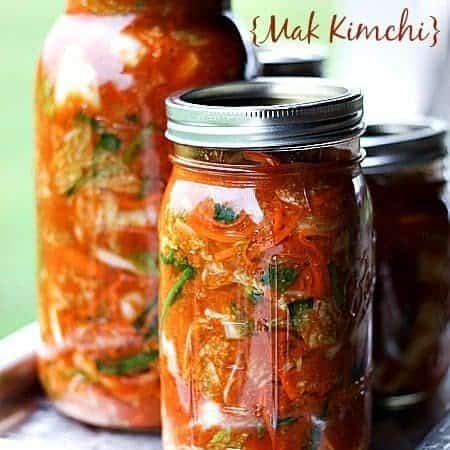
Ingredients
- 3-8 pounds napa cabbage
- 2 bunches green onions trimmed of the root bits
- 2-3 large carrots peeled, thinly julienned
- 1/2 cup kosher salt
- 1/2 cup korean chili powder
- 15-20 cloves garlic overdoing garlic makes this stay on your breath more than usual., peeled
- 4-6 inches ginger peeled, rough chopped
- 1 tablespoon fish sauce
- unsweetened pear juice or unsweetened apple juice
- 4 tablespoons white miso paste
Instructions
- Cut the napa cabbage in half longways, then in half again longways. Cut the core out of the four quarters. Cut the cabbage into squares (about 2-3 inches square), pop it in a bowl with the carrots. Sprinkle with the 1/2 cup kosher salt, massage so everything is coated in salt and starting to soften and wilt. Fill with cold, chlorine free water to cover it well and let it soak for at least 1 1/2 hours.
- Pour the cabbage and carrots and liquid into a strainer. Let the brine drain away.
- Lob off the white bits of the green onions and put them in a food processor with the garlic cloves, ginger, miso paste, and korean pepper powder. Zap it on high ’til it’s smooth-ish. Add in the fish sauce and a couple of slops of pear juice and zap it more until it’s about pancake batter consistency… maybe a bit thinner.
- Put the brined cabbabe/carrots in a big, anti-reactive (glass, enamel, or stainless steel) bowl. Rough chop the green parts of the onions and add those to the cabbage/carrots. Pour the chili paste combo over the cabbage and wear gloves to massage it all over the cabbage/carrots green onions so everything is completely covered.
- Pack super tight in canning jars. CRAM it in there. Add a two-piece lid, but just set the ring in place to hold the lid down without screwing it in place. Place it on a rimmed baking dish to catch any spill-over. Let it sit at room temperature for up to 72 hours, until it is bubbly and fragrant. Once every day, insert a clean chopstick or butterknife to release air bubbles. If needed, pour in some additional brine to keep all the vegetables submerged.
- Store on a rimmed sheet in the refrigerator for up to six months, being sure that the vegetables are submerged the whole time. The older it gets, the stronger it will become.
Notes
Nutrition
Nutritional information is an estimate and provided to you as a courtesy. You should calculate the nutritional information with the actual ingredients used in your recipe using your preferred nutrition calculator.
did you make this recipe?
Make sure to tag @foodiewithfam on Instagram and #hashtag it #foodiewithfamily so I can check it out!
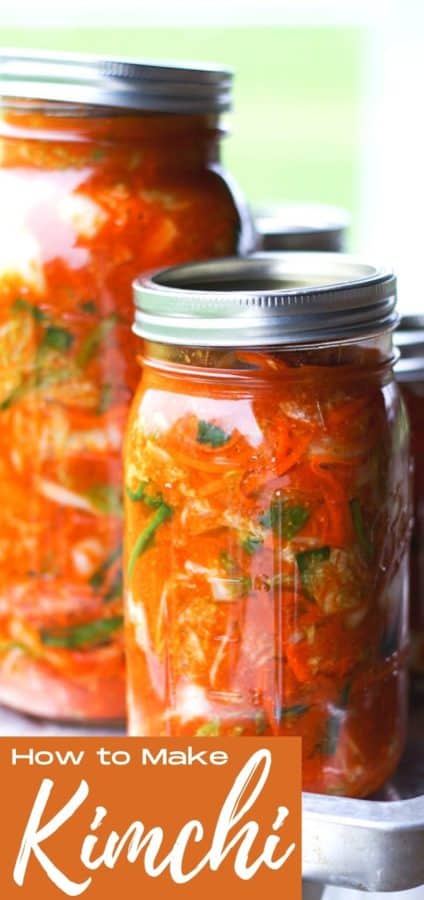
This post was originally published on December 2, 2013 and was updated December 28, 2016, June 2018, and September 2021.
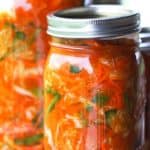



Reader's Thoughts...
Matt Wood says
Thanks for this recipe. I’m on my third batch, my friends and neighbors have been taxing my supply. I initially started making this after a gnarly course of antibiotics (dog bite) and now I am a full addict.
Rebecca says
I’m so glad you like it, Matt! Thanks so much for letting me know!
Jim says
I made this recipe to the letter including 20 cloves of garlic it is AMAZING I have made several different versions of Kimchi but this one is hands down the best.
My brother and I have Kimchi making contest and this recipe blew his away, thank you for posting this recipe
Rebecca says
That makes me so happy, Jim!! I’m so glad you love it.
Playoutside says
How do you make additional brine if my kimchi is only half way submerged?
Step 5 in your recipe:
“If needed, pour in some additional brine to keep all the vegetables submerged.”
Rebecca says
Hi there! Add 4 tablespoons of kosher salt to a quart of cool water, shake ’til salt is dissolved, and voila! You have brine!
Grant Ottesen says
I just made my first batch. I was in Korea in 1982 and 83 Stationed at Dong Da Chan, up buy the DMZ. The Kimchi we used to get was the kind buried in the ground over the winter. It was strong and tasty. All of the guys who had been to Korea before were saying the whole country smelled and it was due to the kimchi. They said it was gross and not to eat it. So naturally I had to try some and it was fantastic. I’m so excited right now because I have 5 Pints of it curing for 72 hours. I can’t wait.
Rebecca says
That’s amazing, Grant! I hope you love it!!
Jon says
Just made this. No idea how it will turn out but I made it wrong. I think the statement “Lob off the white bits of the green onions and put them into a food processor”. I put the green bit in…realised later that it was the other way around. Read it out to my wife and she also thought it referred to the green bits. Maybe you could clarify. Other than that; many thanks for this recipe. Much appreciated.
Rebecca says
Hi Jon- It should still turn out just fine. The green parts provide a nice texture in the finished kimchi, but it won’t hurt it if it was blitzed in.
Becky Z says
I’m confused about the brine. Says to drain the cabbage but then when you are cramming it into the jars does it weep and make it’s own liquid? Then if it needs extra brine are you supposed to save the original brine you drained away?
Rebecca says
Hi Becky! Yes, it weeps and makes its own liquid. If you need extra brine, you can stir 4 teaspoons of kosher salt into a quart of water and use as needed, but you shouldn’t save the original. 🙂
Eva says
I have left out the kimchi to ferment for 72 hrs and while I see it weeping the mixture onto the pan , I don’t see the kimchi bubbling like a carbonated drink. I see the bubbles some when I use a chopstick to release them .
Should I put it in the refrigerator or leave it out longer at room temp until I see the carbonation?
Rebecca says
Hi Eva- You should be fine whichever route you took, but I’d pop it into the fridge now if you haven’t already.
Cheryl says
Who would eat 1894 mg of sodium. A stroke waiting to happen. Need a low sodium recipe
Rebecca says
Oh goodness, you don’t actually eat all of that sodium! Most of it washes away when you drain the brined cabbage! Unfortunately, the recipe nutritional plugin I use doesn’t allow for that in calculating the sodium. 🙂 Rest assured it is substantially less than that!
Audrey Gadson says
I love it. I want learning homemade. I am deaf hard of hearing impraid. Can u give me information where I can buy store which location I live North Carolina near high point nc Thank u Audrey Gadson
s says
Just get to the point. The mumbo-jumbo before any recipe is absolutely annoying
Rebecca says
Ooooh, I bet you are fun at parties. 🙂 The “mumbo-jumbo” has some useful information for people who are looking for it. Otherwise, feel free to scroll to the printable recipe that is available to you for the low-low price of nothing.
E says
I’m scrolling through here while my cabbage is soaking and I’m dying. ? polite food blogger clapback for the win.
E says
Also ps I love that you are a barre instructor and boy mom. Girl after my own heart. I will have to check out the rest of your blog…really impressed with the level of fermentation troubleshooting you’re offering to people. Makes me feel less trepidatious about attempting this!
Rebecca says
Thanks so much, E! I’m so glad you’re here. And I hope you love the rest of the food here, too!! <3
Jinhee says
May I suggest some?
Im Korean and I want to tell you. We never use miso paste when making kimchi. Miso isnt korean but japanese. We use coarse sea salt, korean style fish sauce or salted shrimp to taste. If you use one of them, you can make more authentic and deliciouse kimchi.
Rebecca says
Thank you so much, Jinhee! I do understand that miso is originally Japanese, but I bought a Korean brand of miso for my kimchi because doenjang was really hard to find and found it added a lovely kickstart to the kimchi. The reason I wanted the doenjang/miso was so that if someone wanted vegan kimchi, they could swap out the fish sauce for soy sauce and call it a day. 🙂 And while mine may not be perfectly authentic, I promise it’s tasty. 🙂 I’ll try it with your substitutions sometime soon when I make it, though, because I am not vegan! 🙂
Beth says
This looks amazing. I plan to make this, because I am following a diet where I need to eat Kimchi every day. What size canning jars are you using and how many does it take for this recipe? Thanks!
Michele says
Beth, what diet is that?
Bill Russell says
I disagree with one part of the recipe. The cabbage/carrots should be not just drained, but rinsed several times. This will reduce the sodium content to close to zero. Fermentation will proceed normally without the salt.
Amy Goodrich says
Love this recipe and your website!
I took it as an inspiration to make my own version and it rocked. I left out the fish sauce…
I made a youtube video of the recipe.
Thanks for putting out this great info and amazing pictures!
Amy
Rebecca says
You’re very welcome, Amy! I’m so glad you liked it!
Rachel says
Recipe sounds amazing! The author does an great job explaining the preparation. What a fun read!
Rebecca says
Thanks so much, Rachel! 🙂
Jordan Barntsen says
Hi Rebecca!
I found your recipe on a pseudo-journey to make foreign foods. Is there any recommendation on stuffing the jars? Would it be better to spoon it into the jars or pack it in with my hands? I’m also having a difficult time finding fish sauce in the grocery store. Would soy sauce and a touch of anchovy paste be a suitable alternative? I would sincerely appreciate your expert opinion considering that this will be my first time making kimchi.
Best Regards,
Jordan
Rebecca says
Hey Jordan! Welcome! That sounds like a very nice substitution if you can’t find it and would prefer not to order it. I’d be careful not to use an anchovy paste that has oil or additives in it, though!
Lynn Evans says
Thankyou for your recipe. Your picture looks just like the jar I saw yesterday when I was introduce to it , in a kimchi Quesadilla. I shall be buying the ingredients this weekend and giving it a go.
Sam says
How do you figure the sodium content in the Nutrition Facts for this recipe? It seems high if you are pouring the brine off. I buy high quality kimchee in the store (without vinegar or sugar) and the sodium content is significantly lower than this.
Rebecca says
Hi Sam- I agree that the count in the nutritional information is probably high. I am not a dietician, so I use a nutritional calculator for this and it doesn’t have a way to account for parts of the recipe that are used and removed. Obviously, there will be some sodium left from the brining process, but it’s definitely not ALL the salt or even a majority of it. I’m sorry if you need something more dialed in than what I’m able to provide, but I’m not qualified -nutritionally speaking- to let you know just how much sodium is left from that process. I can, however, guarantee that the final sodium count is far lower. 🙂
Scott Bard says
You say “add brine” while in the jars which gives me the impression it was bottled with brine, but you drain off all the brine early on in the recipe. What’s the deal?
Scott Bard says
Never mind, I see I wasn’t the only one confused by this 😉
Rebecca says
You got there before I could. 🙂 I’m glad you found what you needed.
Roberta Turner says
Hi I made a batch of your kimchi after 2 days I tasted it, it seemed really hot. Next batch I will cut back on the Korean chili powder. Is there anything I can do in the meantime to tame it down? Also you said keep covered with brine so I have been adding salt water as it bubbles over is that what I should be doing and if so how much salt to water?
Rebecca says
Hi Roberta- That is exactly what you should be doing. 🙂 I’d add 4 teaspoons to a quart of water and stir to dissolve. You can keep that jar covered in the fridge and use as needed. I will say the kimchi will mellow a bit spice wise as it ages, but in the meantime, you can “cut” it a little by brining some more chopped napa cabbage and carrot in the salt water and stirring it into your kimchi before serving it.
Vanessa says
Am I missing where you tell us about the brine on top while fermenting? At first I thought I was mixing my pickling directions up with this recipe and came back just to check.
If it’s fermenting in the sauce we made, how would we add brine on top? Sorry to bug, I’m just confused.
Thanks!
Vanessa says
Annnnnnnd never mind! It was just way down there. Thanks! I can ‘t wait to try it!
Rebecca says
Hey Vanessa- The brine is only needed if you don’t have enough liquid to cover your vegetables that are fermenting. It’s just 4 tablespoons of salt to a quart of water, stirred to dissolve.